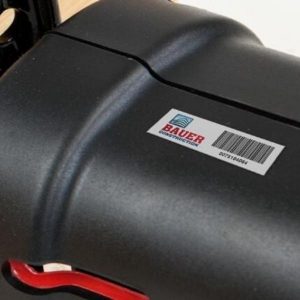Project Description
The Universal Micro measuring at 48mm x 16mm is a great solution to your identification projects that require a small RFID tag with great read range. With a tiny footprint and low profile (57 mils.), the Universal Micro RFID Asset Tag easily fits where other tags are too big and obtrusive.
Supplying up to 2.75 m of read range on metal and 1 .1-5m on plastic, wood and glass, the Micro provides incredible read ranges compared to other tags in its class. Its non-rigid, durable, foam core and polyester construction sets the Micro apart from molded RFID tags allowing for greater flexibility in tag placement.
Developed using the same premise as our original Universal RFID Asset Tag, the Universal Micro is a surface-independent using a patented inlay design and passive RFID technology to obtain excellent read ranges regardless of mounting surface.
Extremely small footprint and thin profile while still achieving excellent read range
Custom engineered foam core designed specifically to obtain optimum read distances
Patented inlay design provides excellent read ranges regardless of surface material–metal, plastic, glass, even wood
Subsurface printing on durable polyester protects printed copy against moderate solvents and caustics/acids
Specifications Data
| Material | Inlay wrapped around 39 mils custom engineered foam. |
| Serialization | Barcode and human-readable equivalent are produced using the latest high-resolution digital technology available, which provides excellent clarity and easy scanning. Code 39 is the standard symbology with a range of 2.7 to 9.4 CPI (characters per inch). Optional linear and 2D symbologies available. |
| Label Copy | The label copy may include block type, stylized type, logos or other designs |
| Colors | Standard colors include black, red, yellow, green, dark blue, purple, orange or blue. Custom spot colors are also available at no additional charge. Due to contrast needed for the bar code scanner, all bar codes are black. |
| Standard Adhesive | Pressure-sensitive acrylic adhesive |
| Frequency Range | Custom designed UHF inlay uses Alien Higgs-EC chip optimized for use at 915 MHZ. |
| Sizes | 48mm x 16mm |
| Packaging | Produced and shipped in roll form. |
| Shipment | 15 business days |
Barcode
Data Matrix
QR Code
RFID
Serial Number
Abrasion Resistance
Chemical Resistance
Heat Resistance
Audio / Visual
Government
Inventory
Restoration
Hospitals
IT Assets
Manufacturing
Schools
-
Chemical Testing
-
Destructive Testing
-
Temperature Testing
-
Read Range Testing
Chemical Test Summary
The Universal Micro tags were attached to a sheet of glass submerged in various chemicals. Observations were made at the
following intervals: 2 hours, 24 hours, 48 hours. A Motorola handheld RFID reader as well as a handheld bar code reader
were used to test the samples.
Chemical Test Data
| Length of immersion | Water | Glass Cleaner | Bathroom Cleaner | Alcohol | Acetone | NaOH pH 12.0 | HNO3 pH 1.0 | Brake fluid |
| 2 hours | no effect | no effect | no effect | adhesive | adhesive ooze | no effect | no effect | no effect |
| 24 hours | no effect | no effect | no effect | adhesive ooze | tag delaminated | no effect | no effect | no effect |
| 48 hours | no effect | no effect | no effect | adhesive | tag delaminated | no effect | no effect | no effect |
Impact resistance test - Impact test consisted of 4.5 kg cylindical weight being dropped vertically from a height of mc 04 .
Tag samples were placed on concrete floor. A tag passed the test if the inlay still reads with Alien ALH-9000 handheld
reader. All tags tested all were still readable after being subject to impact with a 4.5 kg . weight dropped from a vertical
distance of mc 04 .
High-temperature resistance test - These tags were attached to a sheet of glass at raised temperatures for 15 minutes. Tags
were then removed from the oven and tested for readability immediately. Low-temperature resistance test - The tags were
attached to a sheet of glass and exposed to -40°C for 24 hours. Tags were then checked for readability with a Motorola
handheld RFID reader. All samples were readable while at temperature just prior to removal from freezer. No tag
construction defects were observed and adhesive still had a strong bond while in the freezer.
Temperature Test Data
| Temperature | RFID read test (immediately out of oven) | Appearance of tags |
| 93°C | Reads well | No change |
| 150°C | Reads well | No change |
| 205°C | Reads well | Slight curling at edge |
| 260°C | Reads well | Tag destroyed |
Read Range Test Summary
Read Range Test Data
Universal Micro Anechoic Chamber Results
| Sample | Metal | Wood | Glass | Plastic | Cardboard |
| Average | 2.75 meters | 1.50 meters | 1.50 meters | 1.20 meters | 1.20 meters |






